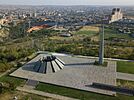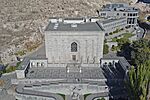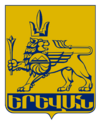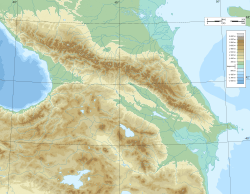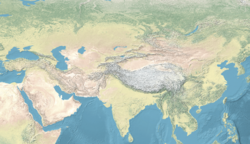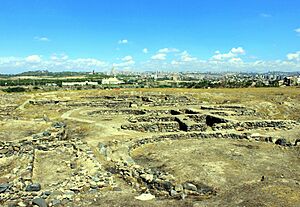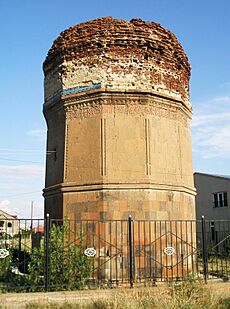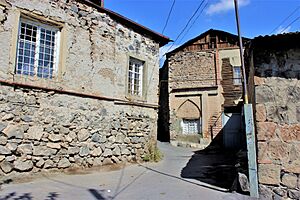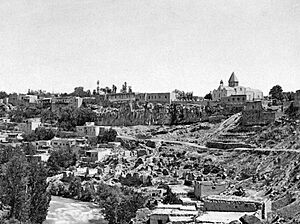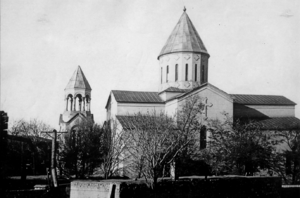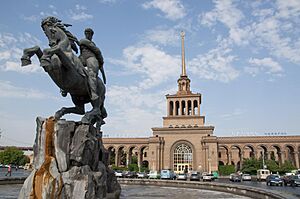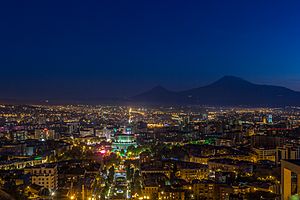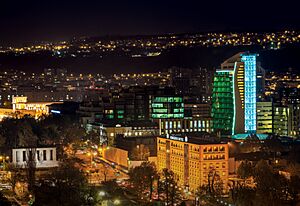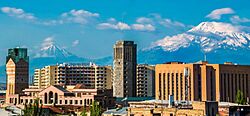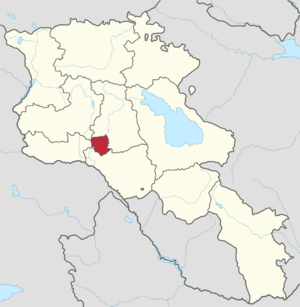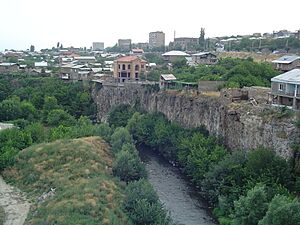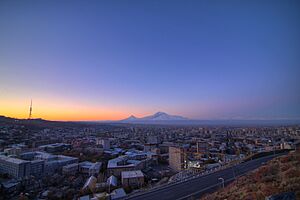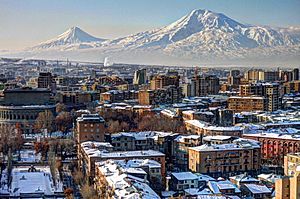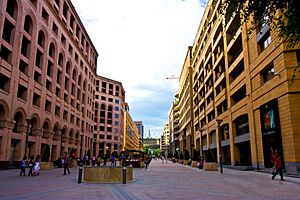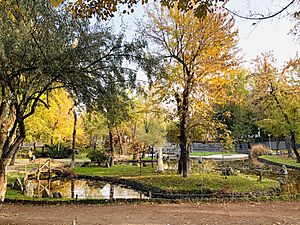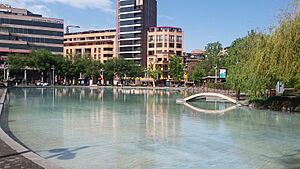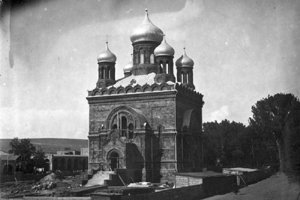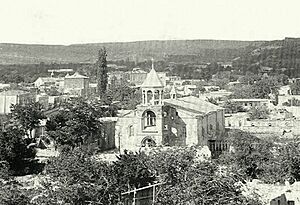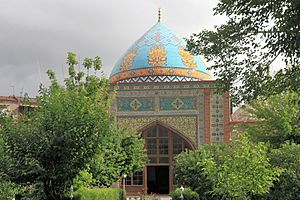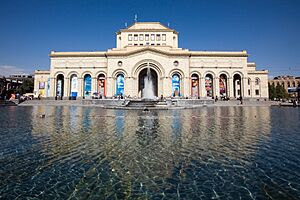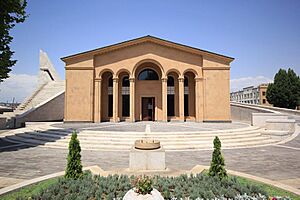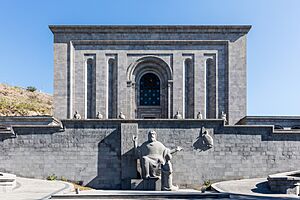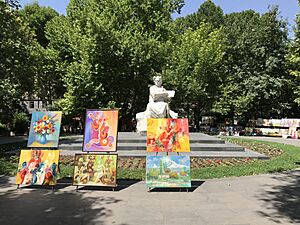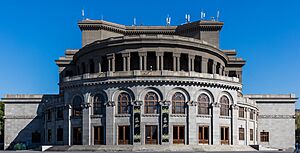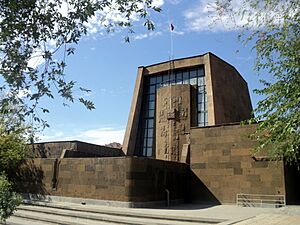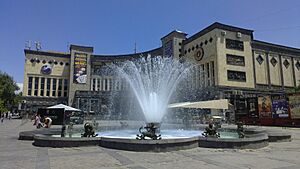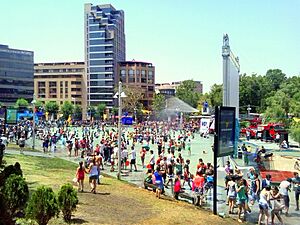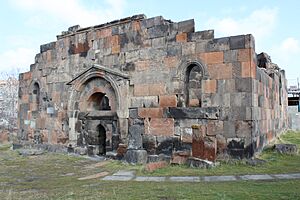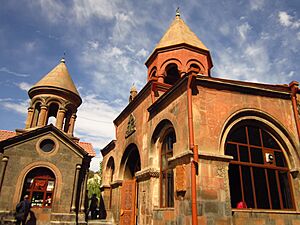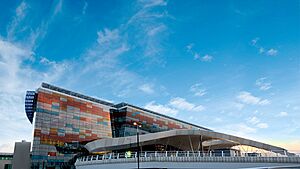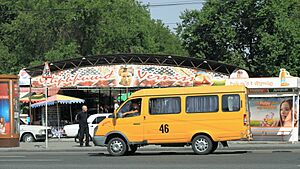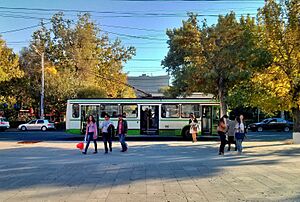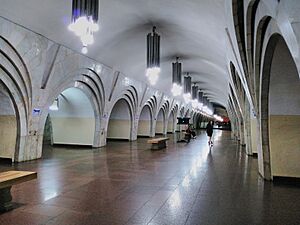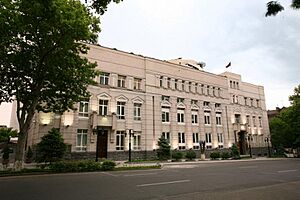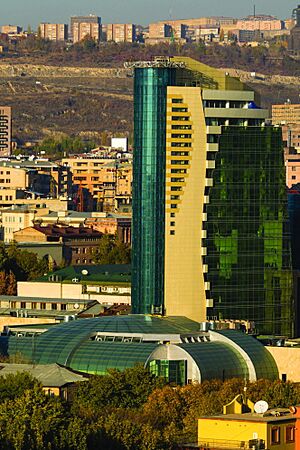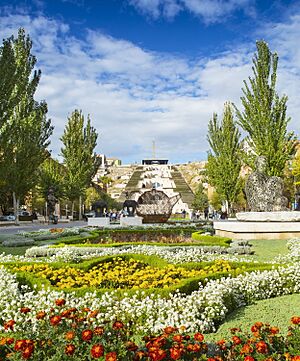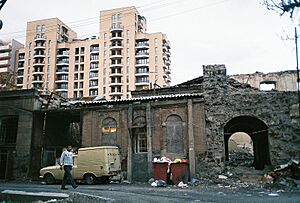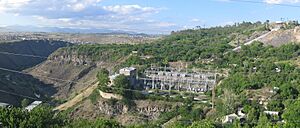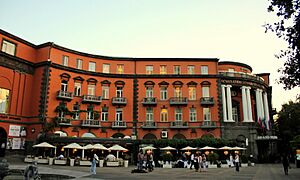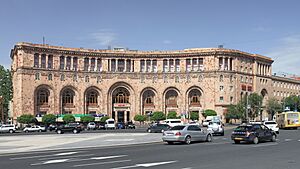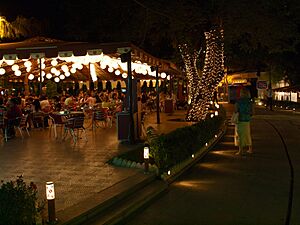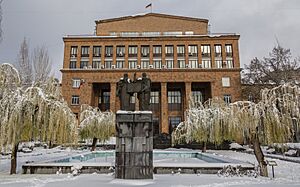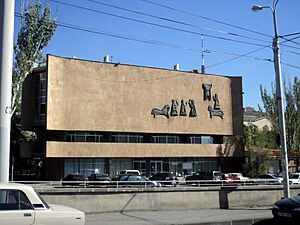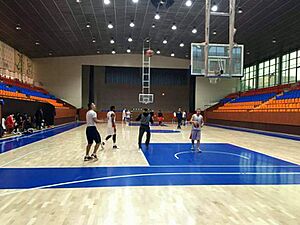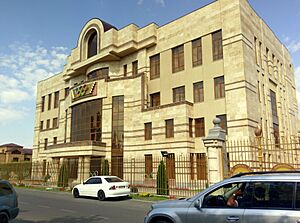Yerevan facts for kids
Quick facts for kids
Yerevan
Երևան
|
|||
|---|---|---|---|
|
Yerevan skyline with Mount Ararat
Hamalir
Cathedral
Opera Theatre
Cascade
Erebuni
Armenian MFA
Republic Square and Government House
|
|||
|
|||
| Nickname(s):
"The Pink City", "Mother City"
|
|||
| Country | |||
| Settled (Shengavit) | c. 3300 BC | ||
| Founded as Erebuni by Argishti I of Urartu | 782 BC | ||
| City status by Alexander II | 1 October 1879 | ||
| Capital of Armenia | 19 July 1918 (de facto) | ||
| Administrative Districts | 12 | ||
| Government | |||
| • Type | Mayor–Council | ||
| • Body | City Council | ||
| Area | |||
| • Capital city | 223 km2 (86 sq mi) | ||
| Highest elevation | 1,390 m (4,560 ft) | ||
| Lowest elevation | 865 m (2,838 ft) | ||
| Population
(2011 census)
|
|||
| • Capital city | 1,060,138 | ||
| • Estimate
(2022)
|
1,092,800 | ||
| • Density | 4,824/km2 (12,490/sq mi) | ||
| • Metro
(2001 estimate)
|
1,420,000 | ||
| Demonym(s) | Yerevantsi(s), Yerevanite(s) | ||
| Time zone | UTC+04:00 (AMT) | ||
| Area code(s) | +374 10 | ||
| International airport | Zvartnots International Airport | ||
| HDI (2021) | 0.794 high · 1st |
||
Yerevan is the capital and largest city of Armenia. It is one of the world's oldest cities where people have lived without stopping. Yerevan is located along the Hrazdan River. It is the main center for government, culture, and industry in Armenia.
Yerevan has been the capital since 1918. It is the fourteenth capital in Armenia's history. The city is also home to the Araratian Pontifical Diocese. This is the largest and one of the oldest parts of the Armenian Apostolic Church.
The city's history began in 782 BC. This is when King Argishti I of Urartu founded the Erebuni Fortress. Erebuni was planned as a major center for ruling and religion. Over time, new capitals were built, and Yerevan became less important. In the 1600s, many people were forced to leave. In 1679, a big earthquake destroyed most of the city. It was then rebuilt.
In 1828, Yerevan became part of the Russian Empire. Many Armenians who had been moved away in the 1600s came back. After World War I, Yerevan became the capital of the First Republic of Armenia. Thousands of survivors of the Armenian genocide came to the city. Yerevan grew very fast in the 1900s when Armenia was part of the Soviet Union. It changed from a small town to a major cultural, artistic, and industrial center. It also became the seat of the national government.
As Armenia's economy grew, Yerevan changed a lot. Many new buildings were built since the early 2000s. Shops, restaurants, and cafes, which were rare before, became common. In 2011, Yerevan had over 1 million people. This was more than 35% of Armenia's total population. In 2022, the population was about 1,092,800. UNESCO named Yerevan the World Book Capital in 2012.
Some famous landmarks in Yerevan include the Erebuni Fortress, which is like the city's birthplace. The Katoghike Tsiranavor church is the oldest church still standing. The Saint Gregory Cathedral is the largest Armenian cathedral in the world. Tsitsernakaberd is a special memorial for the victims of the Armenian genocide. The city has many opera houses, theaters, museums, and libraries. The Yerevan Opera Theatre is the main performance hall. The National Gallery of Armenia is the biggest art museum. It shares a building with the History Museum of Armenia. The Matenadaran holds one of the world's largest collections of old books and manuscripts.
Contents
- What's in a Name? The Story of Yerevan's Name
- City Symbols: What Represents Yerevan?
- Yerevan's Long History: From Ancient Times to Today
- Early Settlements: Life Before Erebuni
- Erebuni Fortress: The Birth of Yerevan
- Later Ancient Times: Changes and Decline
- Medieval Periods: Arab, Bagratid, and Mongol Rule
- Turkic Tribes and Iranian Rule: Challenges and Rebuilding
- Russian Rule: Modernization and Growth
- Brief Independence: The First Republic
- Soviet Rule: A Modern City Emerges
- After Independence: Yerevan Today
- City Landscape: Geography and Climate
- Who Lives in Yerevan? Demographics and Religion
- Culture and Arts: What to See and Do
- Getting Around: Transportation in Yerevan
- Economy and Services: How Yerevan Works
- Learning and Research: Education and Science
- Sports in Yerevan
- Yerevan's Global Connections: Sister Cities
- Famous People from Yerevan
- See also
What's in a Name? The Story of Yerevan's Name
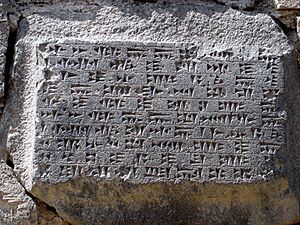

No one knows for sure where the name Yerevan comes from. One idea is that it was named after an Armenian king, Yervand (Orontes) IV. He was the last ruler from the Orontid dynasty. He also founded the city of Yervandashat.
However, it's more likely that the name comes from the Urartian military fort called Erebuni. King Argishti I of Urartu founded this fort in 782 BC. It was built where Yerevan is today. "Erebuni" might mean "to take" or "to capture" in the Urartian language. So, the fort's name could mean "capture," "conquest," or "victory." Over time, as the Urartian language mixed with Armenian, the name changed to Yerevan.
Some old Christian Armenian writers had another idea. They linked the name to the story of Noah's Ark. After the ark landed on Mount Ararat and the flood waters went down, Noah looked towards Yerevan. He supposedly said "Yerevats!" which means "it appeared!" in Armenian. This is said to be how the name Yerevan came about.
In later times, when Yerevan was ruled by Turkic and Persian empires, it was called Iravân in Persian. Under Russian rule in the 1800s and early 1900s, it was known as Erivan. The city was officially renamed Yerevan in 1936.
City Symbols: What Represents Yerevan?

The most important symbol of Yerevan is Mount Ararat. You can see it from almost anywhere in the capital. The city's seal shows a crowned lion. This lion stands on a platform with a shield. The shield has Mount Ararat on top and half of an Armenian eternity sign at the bottom. The emblem is a blue-bordered rectangle.
On September 27, 2004, Yerevan chose its own anthem, "Erebuni-Yerevan." The words were written by Paruyr Sevak, and the music by Edgar Hovhannisyan. The city also chose a new flag. The flag is white with the city's seal in the middle. Twelve small red triangles surround the seal. These triangles stand for the twelve historic capitals of Armenia. The flag also uses the three colors of the Armenian National flag. The lion on the seal is orange with blue edges.
Yerevan's Long History: From Ancient Times to Today
Early Settlements: Life Before Erebuni
People have lived in the area of Yerevan since about 3200 BC. This was during the early Bronze Age. The southern part of the city, now called Shengavit, has been populated for a very long time.
Archaeologists have found many layers of history at the Shengavit site. These layers show that people lived there between 3200 BC and 2500 BC. They found large round buildings with square rooms next to them. They also found smaller round buildings. In 2010 and 2012, they even found places used for ancient rituals.
Erebuni Fortress: The Birth of Yerevan
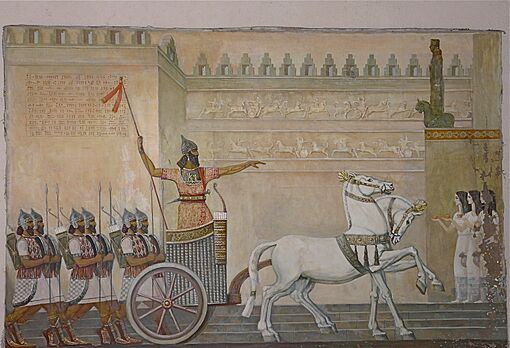
The ancient kingdom of Urartu was formed in the 800s BC. In 782 BC, King Argishti I ordered the building of the Urartian military fort of Erebuni. This fort was meant to protect against attacks from the north. An old stone carving found at Erebuni Fortress says that Argishti built this strong fort. He built it for the glory of Urartu and to scare his enemies. He also said the land was a desert before he built great things on it.
During the time of Urartu's power, canals and artificial lakes were built in Erebuni. These helped with farming.
In the mid-600s BC, the city of Teishebaini was built about 7 kilometers west of Erebuni. King Rusa II of Urartu built it on a hill called Karmir Blur. This was to protect Urartu's eastern borders. The city had a large palace with many rooms and a fort for the god Teisheba. However, Teishebaini was destroyed in 585 BC by other tribes.
Later Ancient Times: Changes and Decline
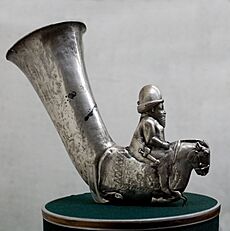
After the Urartu kingdom fell, Erebuni became part of the Median Empire in 590 BC. Then, in 550 BC, it became part of the Achaemenid Empire. Erebuni was an important center for trade during this time.
When Alexander the Great defeated the Achaemenid Empire, Armenia became an independent kingdom. New cities like Armavir and Yervandashat were built. Because of this, Erebuni slowly became less important. Later, under the Artaxiad dynasty, even more new cities were built. Erebuni lost its role as a main city.
Under the Arsacid dynasty of Armenia (54–428 AD), other cities like Vagharshapat and Dvin grew. Erebuni became even less important. It was only mentioned in one old text from the 200s AD. Armenia became a Christian nation in the early 300s AD.
Medieval Periods: Arab, Bagratid, and Mongol Rule
In 658 AD, Arab Islamic armies conquered Yerevan. It became part of the Emirate of Armenia. Trade with Arabs grew, and Yerevan became important for trade routes. It is likely that the name "Erebuni" changed to "Yerevan" around this time.
After two centuries, the Bagratid princes took control. King Ashot I of Armenia freed Yerevan in 850. Yerevan was a safe part of the kingdom. However, it was not a main city for the Bagratids.
Later, the Seljuks ruled the region. Then, the Zakarid Principality grew. After the Mongols captured Ani in 1236, Armenia became a Mongol protectorate. The Zakarids ruled until 1360.
Turkic Tribes and Iranian Rule: Challenges and Rebuilding
In the late 1300s, the Aq Qoyunlu Turkic tribe took over Armenia. In 1400, Timur invaded. Many people were taken as slaves, and Yerevan became empty.
In 1410, the Kara Koyunlu Turkic tribe took control. They made Yerevan the center of a new area called Chukhur Saad. This period was mostly peaceful, and some towns were rebuilt. But later, wars brought more destruction. Many Armenians were taken captive.
After the Armenian Kingdom of Cilicia fell in 1375, the main seat of the Armenian Church moved back to Vagharshapat near Yerevan in 1441. This made Yerevan an important economic and cultural center in Armenia.

In 1501–02, the Safavid dynasty of Iran conquered Yerevan. It became the center of the Erivan Province. For the next 300 years, it was mostly under Iranian rule. Yerevan was often fought over by the Iranian and Ottoman empires.
In 1604, Shah Abbas I of Persia ordered the deportation of hundreds of thousands of Armenians to Persia. Because of this, Yerevan's Armenian population dropped to 20%. Muslims became the majority. However, Armenians were important for trade and business.
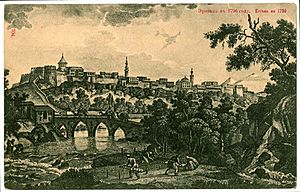
On June 7, 1679, a huge earthquake destroyed the city. It was rebuilt. In 1724, the Erivan Fortress was attacked by the Ottoman army and fell. After a short period of Ottoman rule, Yerevan became part of the Erivan Khanate under the Afsharid dynasty of Iran. This lasted until 1828.
Russian Rule: Modernization and Growth

During the Russo-Persian War (1826–28), Russian troops captured Yerevan on October 1, 1827. Iran officially gave Yerevan to Russia in 1828. After 300 years of Iranian rule, Yerevan became part of the Russian Empire. This period lasted until 1917.
The Russians helped Armenians who had been moved to Iran in the 1600s to return. This made the Armenian population in Yerevan grow from 28% to 53.8%. Yerevan became the center of the new Armenian Oblast from 1828 to 1840. Later, it became the center of the Erivan Governorate.
In the 1800s, Yerevan was a small town with narrow streets. Many schools were opened. The first major plan for Yerevan was made in 1856. New colleges and the English Park were opened. In 1879, Yerevan got city status. The first printing house opened in 1874, and the first theater in 1879.
Yerevan grew quickly under Russian rule. Old buildings were torn down, and new European-style buildings were built. By the early 1900s, Yerevan had over 29,000 people. In 1902, a railway line connected Yerevan to other cities. The first public library opened in the same year. Electricity and telephone lines came to the city in the early 1900s.
Brief Independence: The First Republic

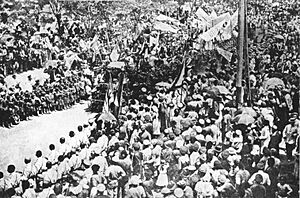
In 1917, the Russian Empire collapsed. Armenian, Georgian, and Muslim leaders formed the Transcaucasian Federation.
The Turkish army advanced towards Yerevan in May 1918. Armenians from all walks of life fought back. They defeated the Turkish army in important battles. On May 28, 1918, Armenia declared its independence. Yerevan became the capital of the new First Republic of Armenia. The city welcomed over 75,000 refugees from the Armenian genocide.
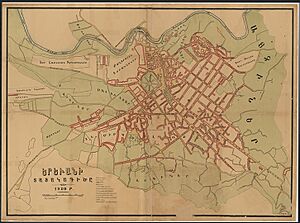
In 1919, the Yerevan State University was opened. Armenia gained international recognition after the Treaty of Sèvres in 1920. However, Yerevan fell to the Bolsheviks on December 2, 1920. Armenia became part of Soviet Russia.
Soviet Rule: A Modern City Emerges

On December 2, 1920, Yerevan became part of the Armenian Soviet Socialist Republic. This republic later joined with Georgia and Azerbaijan to form the Transcaucasian SFSR.
Under Soviet rule, Yerevan became the first city in the Soviet Union to have a general plan. This plan was made by Alexander Tamanian in 1924. It was designed for 150,000 people. The city quickly grew into a modern industrial center with over a million people. New schools, science centers, and cultural places were built.
Tamanian's plan mixed Armenian traditions with modern city design. Many old buildings, including churches and the Erivan Fortress, were torn down. New districts were named after Armenian communities destroyed during the Armenian genocide. After World War II, German prisoners of war helped build new structures like the Kievyan Bridge.
The central Kentron district became the most developed area. Most important institutions were located there. In 1965, Yerevan saw the first protest in the Soviet Union. People demanded that the Armenian Genocide be recognized. In 1968, the city celebrated its 2,750th anniversary.
In the 1980s, Yerevan played a big role in Armenia's movement for democracy. People protested about issues like Nagorno-Karabakh and independence. In 1988, almost a million Armenians protested in the city's Theater Square.
After Independence: Yerevan Today
After the dissolution of the Soviet Union, Yerevan became the capital of Armenia on September 21, 1991. The early years were hard, with problems getting gas and electricity.
Since 2000, central Yerevan has seen a lot of construction. Many new multi-story buildings have gone up. This is part of big city planning projects. Prices for apartments in the city center have increased a lot. New streets and avenues like Northern Avenue were opened.
However, many historic buildings on Aram Street were destroyed or changed. Only a few old structures remain.
The first big protest after independence happened in September 1996. People protested the results of the presidential election. In February 2008, there were more protests. These led to 10 deaths and a state of emergency.
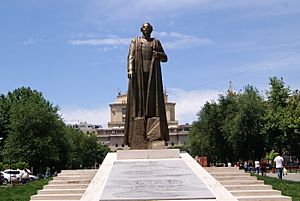
In July 2016, a group of armed men took hostages at a police station. They demanded the release of an opposition leader. After two weeks, the crisis ended, and the men surrendered.
City Landscape: Geography and Climate
Yerevan's Location and Look
Yerevan is about 990 meters (3,248 feet) above sea level. It is one of the fifty highest cities in the world with over 1 million people.
The city is on the banks of the Hrazdan River. It is northeast of the Ararat Plain. Mountains surround the upper part of the city on three sides. The city slopes down to the Hrazdan River in the south. The river flows through a beautiful canyon, dividing Yerevan.
Yerevan is in the middle of the Armenian Highland. It is not part of any province in Armenia. It has a special status as the country's capital. It is bordered by other provinces like Kotayk and Ararat.
The Erebuni State Reserve is about 8 km (5 miles) southeast of the city center. It is between 1300 and 1450 meters (4,265 and 4,757 feet) above sea level. This reserve is mainly semi-deserted mountain-steppes.
Weather in Yerevan
Yerevan has a continental steppe climate. This means it has long, hot, dry summers and short, cold, snowy winters. This is because the city is on a plain surrounded by mountains. It is also far from the sea.
Summers are usually very hot, with temperatures in August reaching up to 40°C (104°F). Winters are cold with snow and freezing temperatures. January can be as cold as -15°C (5°F) or lower. The city does not get much rain, about 318 mm (12.5 inches) per year. Yerevan gets about 2,700 hours of sunshine each year. On July 12, 2018, Yerevan recorded its highest temperature ever: 43.7°C (110.7°F).
| Climate data for Yerevan (1991–2020, extremes 1885–present) | |||||||||||||
|---|---|---|---|---|---|---|---|---|---|---|---|---|---|
| Month | Jan | Feb | Mar | Apr | May | Jun | Jul | Aug | Sep | Oct | Nov | Dec | Year |
| Record high °C (°F) | 19.5 (67.1) |
19.6 (67.3) |
27.6 (81.7) |
35.0 (95.0) |
36.1 (97.0) |
41.1 (106.0) |
43.7 (110.7) |
42.0 (107.6) |
40.0 (104.0) |
34.1 (93.4) |
26.0 (78.8) |
21.0 (69.8) |
43.7 (110.7) |
| Mean daily maximum °C (°F) | 1.7 (35.1) |
6.3 (43.3) |
13.7 (56.7) |
19.8 (67.6) |
25.1 (77.2) |
30.9 (87.6) |
34.5 (94.1) |
34.4 (93.9) |
29.2 (84.6) |
21.6 (70.9) |
12.8 (55.0) |
4.2 (39.6) |
19.5 (67.1) |
| Daily mean °C (°F) | −3.5 (25.7) |
0.0 (32.0) |
7.0 (44.6) |
12.9 (55.2) |
17.7 (63.9) |
23.1 (73.6) |
26.8 (80.2) |
26.7 (80.1) |
21.4 (70.5) |
14.0 (57.2) |
5.8 (42.4) |
−0.8 (30.6) |
12.6 (54.7) |
| Mean daily minimum °C (°F) | −7.8 (18.0) |
−5.4 (22.3) |
0.9 (33.6) |
6.4 (43.5) |
10.8 (51.4) |
15.1 (59.2) |
19.1 (66.4) |
18.9 (66.0) |
13.2 (55.8) |
7.1 (44.8) |
0.1 (32.2) |
−4.9 (23.2) |
6.1 (43.0) |
| Record low °C (°F) | −27.6 (−17.7) |
−26 (−15) |
−19.1 (−2.4) |
−10.9 (12.4) |
−0.6 (30.9) |
3.7 (38.7) |
7.5 (45.5) |
7.9 (46.2) |
0.1 (32.2) |
−6.5 (20.3) |
−14.7 (5.5) |
−28.3 (−18.9) |
−28.3 (−18.9) |
| Average precipitation mm (inches) | 21 (0.8) |
21 (0.8) |
60 (2.4) |
56 (2.2) |
47 (1.9) |
24 (0.9) |
17 (0.7) |
10 (0.4) |
10 (0.4) |
51 (2.0) |
25 (1.0) |
21 (0.8) |
363 (14.3) |
| Average extreme snow depth cm (inches) | 5 (2.0) |
3 (1.2) |
1 (0.4) |
0 (0) |
0 (0) |
0 (0) |
0 (0) |
0 (0) |
0 (0) |
0 (0) |
0 (0) |
1 (0.4) |
5 (2.0) |
| Average precipitation days (≥ 1.0 mm) | 4.9 | 4.3 | 6.2 | 8.2 | 9.3 | 5.7 | 3 | 2.4 | 2.4 | 5.1 | 4.4 | 5 | 60.9 |
| Average rainy days | 2 | 4 | 8 | 12 | 12 | 8 | 5 | 4 | 4 | 8 | 7 | 4 | 78 |
| Average snowy days | 7 | 7 | 2 | 0.2 | 0 | 0 | 0 | 0 | 0 | 0.1 | 1 | 5 | 22 |
| Average relative humidity (%) | 75.0 | 67.6 | 58.3 | 55.5 | 54.6 | 46.0 | 42.9 | 41.1 | 45.7 | 57.8 | 68.6 | 77.0 | 57.2 |
| Mean monthly sunshine hours | 104.5 | 136.8 | 186.5 | 206.5 | 267.1 | 326.6 | 353.9 | 333.7 | 291.5 | 217.0 | 159.9 | 91.0 | 2,675 |
| Source 1: Pogoda.ru.net | |||||||||||||
| Source 2: NOAA (sun, humidity and precipitation days), | |||||||||||||
City Buildings and Design
The Yerevan TV Tower is the tallest building in the city. It is one of the tallest structures in the South Caucasus.
The Republic Square, the Yerevan Opera Theatre, and the Yerevan Cascade are main landmarks. They were designed by architect Alexander Tamanian and Jim Torosyan.
Since 2000, Yerevan has been redeveloped. Many old buildings have been replaced with new ones. This has caused some debate. Some people are sad to see historic buildings from the Russian Empire era disappear.
Major new buildings include the Saint Gregory Cathedral. Also, the new Yerevan City Council building and the new part of the Matenadaran institute. The Cafesjian Center for the Arts at the Cascade is another new addition. The Northern Avenue is a modern street with new buildings.
Aram Street shows traditional Yerevan architecture. The new Northern Avenue shows modern styles.
As of May 2017, Yerevan had 4,883 apartment buildings. It also had 65,199 street lamps on 39,799 posts. The city has 1,080 streets, totaling 750 km (466 miles) in length.
Green Spaces: Parks and Lakes
Yerevan is a busy city, but it has many public parks. The park in Erebuni District, with its artificial lake, is the oldest. It dates back to King Argishti I of Urartu in the 8th century BCE. In 2011, it was renovated and named Lyon Park.
The Lovers' Park and the English Park are popular. They date back to the 1700s and 1800s. The Yerevan Botanical Garden (1935) and Victory Park (1950s) are large green areas. The Circular Park is also a big green space.
The Yerevan Opera Theatre Park, with its artificial Swan Lake, is a favorite spot. In winter, the lake becomes an ice-skating rink.
The Yerevan Lake is an artificial lake. It was opened in 1967 on the Hrazdan riverbed. It covers an area of 0.65 square kilometers (0.25 square miles).
Each district in Yerevan has its own public park. Examples include Buenos Aires Park and Tumanyan Park.
Who Lives in Yerevan? Demographics and Religion
| Year | Armenians | Azerbaijanis | Russians | Others | Total | ||||
|---|---|---|---|---|---|---|---|---|---|
| c. 1650 | absolute majority | — | — | — | — | ||||
| c. 1725 | absolute majority | — | — | — | 20,000 | ||||
| 1830 | 4,132 | 35.7% | 7,331 | 64.3% | 195 | 1.7% | 11,463 | ||
| 1831 | 4,484 | 37.6% | 7,331 | 61.5% | 105 | 0.9% | 11,920 | ||
| 1873 | 5,900 | 50.1% | 5,800 | 48.7% | 150 | 1.3% | 24 | 0.2% | 11,938 |
| 1886 | 7,142 | 48.5% | 7,228 | 49.0% | 368 | 2.5% | 14,738 | ||
| 1897 | 12,523 | 43.2% | 12,359 | 42.6% | 2,765 | 9.5% | 1,359 | 4.7% | 29,006 |
| 1908 | 30,670 | ||||||||
| 1914 | 15,531 | 52.9% | 11,496 | 39.1% | 1,628 | 5.5% | 711 | 2.4% | 29,366 |
| 1916 | 37,223 | 72.6% | 12,557 | 24.5% | 1,059 | 2.1% | 447 | 0.9% | 51,286 |
| 1919 | 48,000 | ||||||||
| 1922 | 40,396 | 86.6% | 5,124 | 11.0% | 1,122 | 2.4% | 46,642 | ||
| 1926 | 59,838 | 89.2% | 5,216 | 7.8% | 1,401 | 2.1% | 666 | 1% | 67,121 |
| 1931 | 80,327 | 90.4% | 5,620 | 6.3% | 2,957 | 3.3% | 88,904 | ||
| 1939 | 174,484 | 87.1% | 6,569 | 3.3% | 15,043 | 7.5% | 4,300 | 2.1% | 200,396 |
| 1959 | 473,742 | 93.0% | 3,413 | 0.7% | 22,572 | 4.4% | 9,613 | 1.9% | 509,340 |
| 1970 | 738,045 | 95.2% | 2,721 | 0.4% | 21,802 | 2.8% | 12,460 | 1.6% | 775,028 |
| 1979 | 974,126 | 95.8% | 2,341 | 0.2% | 26,141 | 2.6% | 14,681 | 1.4% | 1,017,289 |
| 1989 | 1,100,372 | 96.5% | 897 | 0.0% | 22,216 | 2.0% | 17,507 | 1.5% | 1,201,539 |
| 2001 | 1,088,389 | 98.6% | — | 6,684 | 0.61% | 8,415 | 0.76% | 1,103,488 | |
| 2011 | 1,048,940 | 98.9% | — | 4,940 | 0.5% | 6,258 | 0.6% | 1,060,138 | |
| Historical population | ||
|---|---|---|
| Year | Pop. | ±% |
| 1897 | 29,006 | — |
| 1926 | 62,180 | +114.4% |
| 1939 | 200,396 | +222.3% |
| 1959 | 509,340 | +154.2% |
| 1970 | 775,028 | +52.2% |
| 1979 | 1,025,959 | +32.4% |
| 1989 | 1,201,539 | +17.1% |
| 2001 | 1,103,488 | −8.2% |
| 2011 | 1,060,138 | −3.9% |
| 2022 | 1,086,677 | +2.5% |
Yerevan was once a small town. It grew into a large capital city with over a million people. Before the Soviet Union fell, most people in Yerevan were Armenians. There were also smaller groups of Russians, Kurds, and Azerbaijanis. However, during the First Nagorno-Karabakh War (1988-1994), many Azerbaijanis left. A large part of the Russian population also left during the economic crisis in the 1990s. Today, most people in Yerevan are Armenian.
After the Soviet Union broke up, thousands of people left Armenia due to economic problems. Yerevan's population dropped from 1,250,000 in 1989 to 1,060,138 in 2011. However, the population has been growing again since then.
Most people in Yerevan speak the Yerevan dialect. This is an Eastern Armenian dialect that likely formed in the 1200s. It is the most common Armenian dialect today.
Ethnic Groups in Yerevan
Yerevan was first settled by Armenians. It remained mostly Armenian until the 1400s. The Erivan Fortress, built in the 1580s, had many Muslim soldiers. But the city itself was mainly Armenian. A French traveler in the 1600s said Yerevan was only populated by Armenians. Even after many Armenians were forced to leave in the 1600s, Armenians were still the majority.
In the early 1800s, Yerevan had a Muslim majority. This changed after the Russo-Persian War (1826–1828). Many Armenians from Persia and Turkey moved to Yerevan.
After the Armenian genocide, many Armenian refugees came to Yerevan. In 1919, about 75,000 Armenian refugees arrived. Most were from the Van region. Sadly, many died from diseases.
From 1921 to 1936, about 42,000 Armenians from other countries moved to Soviet Armenia. Most settled in Yerevan. Another large group of Armenians moved to Yerevan from 1946 to 1948. This made Yerevan's population even more Armenian. The Azerbaijani population in Yerevan dropped a lot by 1989.
Today, there are over 22,000 Indian residents in Armenia. Many of them live in Yerevan. They run businesses, Indian restaurants, and study at universities.
Religious Life in Yerevan
Armenian Apostolic Christianity
Armenian Apostolic Christianity is the main religion in Armenia. The 5th-century Saint Paul and Peter Church was one of the earliest churches in Yerevan. It was destroyed by the Soviets in 1930. Many other old Armenian churches were also destroyed in the 1930s.
The Araratian Pontifical Diocese is the main church body in Yerevan. The Surp Sarkis Cathedral is its main church. It is the largest and one of the oldest dioceses in the world.
Yerevan is home to the largest Armenian church in the world. This is the Cathedral of Saint Gregory the Illuminator. It was built in 2001 to celebrate 1700 years of Christianity in Armenia. As of 2017, Yerevan has 17 active Armenian churches and four chapels.
Russian Orthodox Churches
After Russia took Yerevan in 1828, many Russian Orthodox churches were built. The Saint Nikolai Cathedral was the largest. The Church of the Intercession of the Holy Mother of God opened in 1916.
Most of these churches were closed or destroyed by the Soviets in the 1930s. The Saint Nikolai Cathedral was destroyed in 1931. The Church of the Intercession was used as a warehouse and then a club. Religious services started again in 1991. A new Holy Cross Russian Orthodox church was built and opened in 2017.
Other Religions in Yerevan
In the mid-1800s, Yerevan had eight mosques. The 18th-century Blue Mosque was restored in the 1990s. It is now the only active mosque in Armenia. It mainly serves Iranian Shia visitors.
Yerevan also has small communities of Yezidis, Molokans, Neopagans, Baháʼís, and Jews.
Culture and Arts: What to See and Do
Yerevan is Armenia's main center for culture, art, and industry. It has many museums, important monuments, and the national library. It also hosts Vardavar, a popular Armenian festival. Yerevan is also known for traditional Armenian carpet weaving.
Museums: Exploring History and Art
Yerevan has many museums and art galleries. The most famous are the National Gallery of Armenia and the History Museum of Armenia. Also, the Cafesjian Museum of Art, the Matenadaran library, and the Armenian Genocide Museum.
The National Gallery of Armenia and the History Museum of Armenia were founded in 1921. The gallery has Armenian art and works by European artists.
The Armenian Genocide Museum is at the Tsitsernakaberd memorial. It shows photos and stories from the Armenian genocide. It honors people who spoke out against the genocide.
The Cafesjian Museum of Art opened in 2009. It is inside the Yerevan Cascade. It has a large collection of glass art. Its gardens show sculptures from Gerard L. Cafesjian's collection.
The Erebuni Museum (1968) is an archaeology museum. It has Urartian artifacts found at the Erebuni Fortress. The Yerevan History Museum tells the story of Yerevan. The Military Museum at the Mother Armenia complex is about Armenian soldiers in wars.
Yerevan also has many art museums. The Sergei Parajanov Museum (1988) is about the artist Sergei Parajanov. The Komitas Museum (2015) is about the composer Komitas. Other art museums include the Charents Museum of Literature and Arts and the Modern Art Museum of Yerevan.
Many famous Armenian artists have house-museums in Yerevan. These include poet Hovhannes Tumanyan and composer Aram Khachaturian.
Libraries: A World of Books
The National Library of Armenia is the main public library. It was founded in 1832. The Khnko Aper Children's Library opened in 1933. Other major libraries include the Avetik Isahakyan Central Library. Each district in Yerevan also has its own public library.
The Matenadaran is a library and research center. It has 17,000 ancient manuscripts and old Bibles. Its collection includes old Armenian, Greek, Aramaic, Hebrew, Latin, and Persian writings.
In 2010, UNESCO named Yerevan the 2012 World Book Capital. This was because of its great plans for books and reading.
Art and Music: Creativity in the City
Yerevan is a historic center for traditional Armenian carpets. Carpet making has a long history here. Today, factories like "Megerian Carpet" make handmade rugs.
The Yerevan Vernissage is an outdoor market. It sells traditional Armenian handmade art, especially wood sculptures and carpets. Saryan Park is known for artists showing their paintings.
Music Scene
Jazz, classical, folk, and traditional music are popular in Yerevan. Many music groups, orchestras, and choirs perform in the city.
The Armenian Philharmonic Orchestra (1925) is one of the oldest music groups. The Armenian National Radio Chamber Choir (1929) won a big prize in 1931. Folk and classical music were taught in state schools. The Sayat-Nova Armenian Folk Song Ensemble was founded in 1938.
In 1939, the Armenian National Academic Theatre of Opera and Ballet opened. It has concert halls for performances.
The Komitas Chamber Music House (1977) is for chamber music. The Karen Demirchyan Sports and Concerts Complex (1983) is the largest indoor venue in Armenia.
Many other musical groups are active in Yerevan. Jazz is also popular. The first jazz band in Yerevan was formed in 1936. The Malkhas jazz club is a popular spot. The Yerevan Jazz Fest is an annual festival.
Armenian rock music started in Yerevan in the 1960s. The Armenian Navy Band is famous for jazz and folk music. Reggae is also becoming popular.
The Cafesjian Center for the Arts holds regular music events. Open-air concerts are often held in summer at places like the Freedom Square.
Dance and Theatre
Traditional dancing is very popular. In summer, people often dance in groups at Northern Avenue.
Professional dance groups were formed in Soviet times. The Armenian Folk Music and Dance Ensemble started in 1938. The Barekamutyun State Dance Ensemble of Armenia was founded in 1987. The Karin Traditional Song and Dance Ensemble performs ancient Armenian dances.
Yerevan has many theater groups. Main state theaters include the Sundukyan State Academic Theatre and the Paronyan Musical Comedy Theatre. There are also special theaters like the Hovhannes Tumanyan Puppet Theatre.
Cinema in Yerevan
Armenian cinema began on April 16, 1923. The first Armenian film studio, Armenfilm, opened in Yerevan in 1924. Namus (1925) was the first Armenian silent film. Pepo (1935) was the first sound film.
Yerevan has many movie theaters, including the Moscow Cinema and Nairi Cinema. The city also hosts film festivals. The Golden Apricot Yerevan International Film Festival is held every year.
Festivals: Celebrating Together
Yerevan organizes many public celebrations. Vardavar is the most popular Armenian festival. It comes from ancient pagan traditions. On Vardavar day, people throw water on each other. The Swan Lake is a popular place for Vardavar celebrations.
The Yerevan Taraz Fest started in 2015. It celebrates traditional Armenian clothing. Yerevan also has annual wine festivals, called Yerevan Wine Days, since 2016. Other popular events include the Watermelon Fest and the Yerevan Beer Fest.
City Landmarks: Monuments and Historic Sites
Historic Buildings
Many of Yerevan's old buildings were destroyed by invasions or earthquakes. But some are still standing and have been restored.
Erebuni Fortress, or Arin Berd, is where Yerevan was founded in 782 BC. Other old structures are found in Shengavit.
The 4th-century Holy Mother of God chapel and the 6th-century Tsiranavor Church are in Avan District. They are among the oldest Christian buildings in the city. Avan was once a suburb but is now part of Yerevan.
Katoghike Church, built in 1264, is one of the best-preserved churches. Zoravor Surp Astvatsatsin Church (1693–94) was built after the big earthquake. Saint Sarkis Cathedral (rebuilt 1835–42) is the main church of the Araratian Pontifical Diocese.
The Blue Mosque, built in the 1760s, is the only active mosque in Armenia. The Red Bridge over the Hrazdan River is a 17th-century structure.
Modern Landmarks

The Yerevan Opera Theater (1933) is a major landmark. So are the Mesrop Mashtots Matenadaran (1959) and the Tsitsernakaberd monument (1967).
Moscow Cinema (1937) is an example of Soviet-era architecture. A monument to the hero David of Sassoun was built near the Yerevan Railway Station in 1959. The Mother Armenia statue (1967) replaced a statue of Joseph Stalin.
Komitas Pantheon is a cemetery for famous Armenians. The Yerablur Pantheon is a military cemetery.
Many new buildings were built after Armenia's independence. These include the Yerevan Cascade and the Saint Gregory Cathedral (2001). A large statue of Garegin Nzhdeh was put up in central Yerevan in 2016.
Getting Around: Transportation in Yerevan
Air Travel
Yerevan is served by Zvartnots International Airport. It is about 12 km (7.5 miles) west of the city center.
A second airport, Erebuni Airport, is south of the city. It is mainly used for military and private flights. The Armenian Air Force has its base there.
City Buses, Vans, and Trolleybuses
Public transport in Yerevan is mostly run by private companies. As of May 2017, there were 39 city bus lines. These use about 425 buses.
However, over half of public transport is still by "public vans," called marshrutka. These are about 1210 Russian-made vans with 13 seats. They operate like buses on 79 different lines. The city plans to replace them with larger buses.
The Yerevan trolleybus system has been running since 1949. Some old trolleybuses have been replaced. As of May 2017, only 5 trolleybus lines are active. The city owns and runs the trolleybus system.
The tram network in Yerevan stopped running in 2004. It cost too much to operate.
There is no ticketing system for public transport. Passengers pay the driver when they get off. The fare is fixed by the authorities.
The central station in Nor Kilikia is the main bus terminal. It has routes to almost all cities in Armenia and to Tbilisi and Tabriz.
Underground Metro System
The Yerevan Metro is a rapid transit system. It has been serving the city since 1981. It has one line that is 12.1 km (7.5 miles) long. There are 10 active stations. The stations look like those in other former Soviet countries.
A new extension with two stations is being built. The first new station, Ajapnyak, will cost US$18 million. The metro carries over 60,000 people daily.
Railway Connections
Yerevan has one central railway station. It is connected to the metro. The station has Soviet-style architecture. Because of blockades, only one international train runs every two days. It goes to Tbilisi, Georgia. In summer, it continues to Batumi on the Black Sea.
There are no trains going south from Yerevan. This is because the railway to Iran passes through a closed border.
The South Caucasus Railway CJSC wants to open the Yerevan-Gyumri-Kars railway line. This would happen if the borders between Armenia and Turkey open.
As of July 2017, trains run from Yerevan to Tbilisi-Batumi, Gyumri, Yeraskh, Araks, and Shorzha.
Taxi Services
Yerevan has taxis available 24/7. Many taxi companies serve the city. There are also online taxi services like GG Taxi, Utaxi, and Yandex.Taxi.
Economy and Services: How Yerevan Works
City Industries
As of 2013, Yerevan produces 41% of Armenia's total industrial goods. The city's industries are very diverse. They include chemicals, metals, machinery, plastics, carpets, textiles, clothing, jewelry, wood products, building materials, and food. Even after the economic crisis of the 1990s, some factories are still running. These are mainly in the petrochemical and aluminum sectors.
Armenian drinks, especially cognac and beer, are famous worldwide. Yerevan has many leading companies that make alcoholic beverages. These include the Yerevan Ararat Brandy Factory and "Beer of Yerevan" (Kilikia Beer). The two tobacco companies in Yerevan are "Cigaronne" and "Grand Tabak."
Carpet making has a long history in Armenia. Yerevan has three major factories that make handmade rugs. "Megerian Carpet" is a leader in this area.
Other big factories in the city include "Nairit" (chemicals and rubber) and Rusal Armenal (aluminum foil). "Grand Candy" makes sweets. "Marianna" makes dairy products. "ATMC" mines travertine stone. Yerevan also has a Watch Factory and a Jewellery Plant.
Food products include processed meat, canned goods, and sweets. Building materials include travertine stone and asphalt.
Money and Banks
Yerevan is a good place for international companies to set up offices. It is Armenia's financial center. The Central Bank of Armenia and the Armenian Stock Exchange are located here. Most of the country's largest banks are also in Yerevan. As of 2013, the city handles over 85% of Armenia's services and 84% of its retail trade.
Many Russian banks and companies operate in Yerevan. These include Gazprom and VTB Bank. ACBA-Credit Agricole is a French bank. HSBC Bank Armenia also operates in Yerevan.
Building and Construction
The construction industry grew a lot in the early 2000s. Yerevan saw a huge building boom. This was funded by Armenian millionaires from other countries. Many old buildings were torn down and replaced with new ones. This also caused real estate prices to go up a lot.
Big construction projects include the Northern Avenue. Also, the renovation of Old Yerevan on Aram Street. The Northern Avenue was finished in 2007. The Old Yerevan project is still ongoing. The city center has also seen major road repairs. The Republic Square was renovated with money from Kirk Kerkorian.
The construction sector slowed down by the end of the 2000s. In 2013, Yerevan still made up over 58% of Armenia's total construction.
In 2017, the government announced new construction plans. A new business district will be built in the city center. A new residential area called Noy (Noah) will also be built.
Energy Production
Yerevan's location on the Hrazdan River helps produce hydroelectricity. Three hydroelectric power plants are in Yerevan: Kanaker HPP, Yerevan-1 HPP, and Yerevan-3 HPP. These plants were privatized in 2003.
The city also has the Yerevan Thermal Power Plant. A modern plant was built in 2007 to generate electricity. In 2017, construction began on a new thermal power plant. It will cost US$258 million and produce 250 megawatts.
Tourism and Fun: What to Do at Night
Tourism in Armenia is growing. Yerevan is a major tourist spot. The city has many luxury hotels, modern restaurants, bars, and nightclubs. The Zvartnots airport has been renovated for more tourists.
Many places in Yerevan attract tourists. These include the dancing fountains of the Republic Square and the State Opera House. Also, the Cascade complex and the ruins of the Urartian city of Erebuni. The largest hotel is the Ani Plaza Hotel. The Armenia Marriott Hotel is in Republic Square. Other major hotels include the Radisson Blu Hotel and the Grand Hotel Yerevan.
The view of Mount Ararat from Yerevan is also a big draw for visitors.
There are many historic sites and churches around Yerevan. These include Garni Temple, Zvartnots Cathedral, and the monasteries of Khor Virap and Geghard.
Yerevan is one of the top 10 safest cities in the world. It has a lively nightlife with many nightclubs, live music venues, and cafes. Casino Shangri La and Pharaon Complex are large entertainment centers.
Many famous music stars perform concerts in Yerevan.
The Yerevan Zoo (1940), the Yerevan Circus (1956), and the Yerevan Water World (2001) are popular entertainment spots.
The Northern Avenue is a popular walking area. It has modern buildings, businesses, restaurants, and cafes. The Yerevan Cascade and "Cafesjian Sculpture Garden" also have many coffee shops and pubs. The "Cafesjian Center for the Arts" holds art events and concerts.
As of 2017, Yerevan has three shopping malls: Dalma Garden Mall (2012), Yerevan Mall (2014), and Rossia Mall (2016).
A study in 2019 found that Yerevan offers a higher quality of life than other capital cities in the South Caucasus.
Learning and Research: Education and Science
Schools and Universities
Yerevan is a major educational center. As of 2017, it has over 250 schools. About 210 are state-owned, and 40 are private. The city also runs 160 kindergartens.
Some well-known international or private schools include the QSI International School of Yerevan and Ayb School.
As of 2018, about 60 universities are in Armenia. Yerevan is home to about 50 universities, nearly half of which are public. Yerevan State University, American University of Armenia, and Yerevan State Medical University are top-rated universities.
Science and Research Centers
Under Soviet rule, Yerevan became a major center for science. The Armenian National Academy of Sciences (1943) leads scientific research in Armenia. It has divisions for math, physics, natural sciences, and social sciences.
After independence, many new research centers opened. These include the CANDLE Synchrotron Research Institute (2010) and Tumo Center for Creative Technologies (2011).
After the Russian invasion of Ukraine in 2022, many Russian professionals came to Yerevan. They included IT experts, bloggers, and journalists. They found Yerevan welcoming and could enter without visas.
Sports in Yerevan
Football (Soccer)
Football is the most popular sport in Yerevan and Armenia. Yerevan has about a dozen. They play in the Armenian Premier League. Successful clubs include Pyunik and Ararat Yerevan.
Hrazdan Stadium is the largest sports venue in Armenia. The Vazgen Sargsyan Republican Stadium is the main home ground for the Armenia national football team.
The Yerevan Football Academy (2010) is a modern training complex. As of 2017, Yerevan has about 130 mini-football pitches in neighborhoods.
Chess: A Smart Game
Armenia is very good at chess. The Chess Federation of Armenia is in the Tigran Petrosian Chess House in Yerevan. Chess is taught in primary schools. Yerevan has many chess teams and schools. In 1996, Yerevan hosted the 32nd Chess Olympiad. Armenian teams from Yerevan won the Chess Olympiad in 2006, 2008, and 2012. Levon Aronian, a top chess player, was born in Yerevan.
Basketball and Tennis
The first professional basketball league in Armenia started in 2017. Yerevan has four teams in this league.
Tennis is also popular in Yerevan. Several tennis clubs operate in the city. Incourt Tennis Club is the largest. Sargis Sargsian and Ani Amiraghyan are successful Armenian tennis players from Yerevan.
Gymnastics and Other Sports
Armenia has produced many Olympic champions in artistic gymnastics. These include Hrant Shahinyan and Albert Azaryan. Yerevan has state-owned gymnastics schools named after them.
The Karen Demirchyan Sports and Concerts Complex is the largest indoor arena. It is used for ice hockey and figure skating. Other indoor arenas host basketball, volleyball, and handball.
The Armenia Sports Union focuses on individual Olympic sports. These include boxing, weightlifting, and wrestling.
The "Yerevan State Sports College of Olympic Reserve" (1971) is a large sports complex. It has schools for many sports.
In 2015, the new Olympic Training Complex, Olympavan, opened. It has training facilities for most Olympic sports.
Horse riding was introduced in 1953. The Hovik Hayrapetyan Equestrian Centre is the main center for horse riding and racing.
Golf came to Yerevan in 1999. The Ararat Valley Country Club is the first golf course in Armenia.
Cycling is becoming popular. The Yerevan Velodrome (2011) is an outdoor track cycling venue.
The Irina Rodnina Figure Skating Centre opened in 2015 to promote figure skating and ice hockey.
Futsal is also popular. Futsal Club Leo from Yerevan is a successful team.
Recently, MMA has become very popular. The Armfighting Professional Federation is based in Yerevan.
Many modern training complexes with swimming pools have opened. These include the Davit Hambardzumyan Swimming School and Gold's Gym.
Yerevan's Global Connections: Sister Cities
Yerevan is part of many international groups. These include the International Assembly of CIS Countries' Capitals and Big Cities. It is also part of the International Association of Francophone Mayors.
Twin Towns and Sister Cities

Yerevan is twinned with many cities around the world:
 Amman, Jordan (2014)
Amman, Jordan (2014) Antananarivo, Madagascar (1981)
Antananarivo, Madagascar (1981) Beirut, Lebanon (1997)
Beirut, Lebanon (1997) Bratislava, Slovakia (2001)
Bratislava, Slovakia (2001) Buenos Aires, Argentina (2000)
Buenos Aires, Argentina (2000) Cambridge, United States (1987)
Cambridge, United States (1987) Carrara, Italy (1973)
Carrara, Italy (1973) Chişinău, Moldova (2005)
Chişinău, Moldova (2005) Damascus, Syria (1997)
Damascus, Syria (1997) Doha, Qatar (2022)
Doha, Qatar (2022) Isfahan, Iran (1995)
Isfahan, Iran (1995) Los Angeles, United States (2007)
Los Angeles, United States (2007) Marseille, France (1992)
Marseille, France (1992) Montreal, Canada (1998)
Montreal, Canada (1998) Nice, France (2007)
Nice, France (2007) Novosibirsk, Russia (2014)
Novosibirsk, Russia (2014) Odesa, Ukraine (1995)
Odesa, Ukraine (1995) Qingdao, China (2023)
Qingdao, China (2023) Riga, Latvia (2013)
Riga, Latvia (2013) Rostov-on-Don, Russia (2005)
Rostov-on-Don, Russia (2005) São Paulo, Brazil (2002)
São Paulo, Brazil (2002) Stavropol, Russia (1994)
Stavropol, Russia (1994) Tbilisi, Georgia (1996)
Tbilisi, Georgia (1996) Tehran, Iran (2023)
Tehran, Iran (2023) Venice, Italy (2011)
Venice, Italy (2011) Volgograd, Russia (2015)
Volgograd, Russia (2015)
Partnerships with Other Cities

Yerevan also works closely with these cities:
 Ashgabat, Turkmenistan (2014)
Ashgabat, Turkmenistan (2014) Athens, Greece (1993)
Athens, Greece (1993) Beijing, China (2009)
Beijing, China (2009) Bucharest, Romania (2013)
Bucharest, Romania (2013) Delhi, India (2008)
Delhi, India (2008) Île-de-France, France (2011)
Île-de-France, France (2011) Khanty-Mansiysk, Russia (2014)
Khanty-Mansiysk, Russia (2014) Lyon, France (1993)
Lyon, France (1993) Kaliningrad, Russia (2009)
Kaliningrad, Russia (2009) Kyiv, Ukraine (1995)
Kyiv, Ukraine (1995) Krasnodar, Russia (2014)
Krasnodar, Russia (2014) Minsk, Belarus (2002)
Minsk, Belarus (2002) Moscow, Russia (1995)
Moscow, Russia (1995) Paris, France (2011)
Paris, France (2011) Pesaro, Italy (2017)
Pesaro, Italy (2017) Podgorica, Montenegro (1974)
Podgorica, Montenegro (1974) Qazvin, Iran (2014)
Qazvin, Iran (2014) Rio de Janeiro, Brazil (2007)
Rio de Janeiro, Brazil (2007) Saint Petersburg, Russia (1997)
Saint Petersburg, Russia (1997) Sofia, Bulgaria (2008)
Sofia, Bulgaria (2008) Stepanakert, Artsakh (2012-2023)
Stepanakert, Artsakh (2012-2023) Tuscany, Italy (1996)
Tuscany, Italy (1996) Warsaw, Poland (2013)
Warsaw, Poland (2013)
Famous People from Yerevan
- Terter Yerevantsi (1290–1350), a writer and poet.
- Khachatur Abovian (1809–1848), a famous writer.
- Hamo Beknazarian (1891–1965), a film director.
- Silva Kaputikyan (1919–2006), a well-known poet.
- Arno Babajanian (1921–1983), a Soviet composer.
- Karen Demirchyan (1932–1999), an important politician.
- Armen Dzhigarkhanyan (born 1935–2020), a Soviet and Armenian-Russian actor.
- Arthur Meschian (born 1949), a composer and architect.
- Ruben Hakhverdyan (born 1950), a singer and songwriter.
- Khoren Oganesian (born 1955), a football player.
- Vardan Petrosyan (born 1959), an actor.
- Hasmik Papian (born 1961), a soprano singer.
- Tata Simonyan (born 1962), a pop singer.
- Garik Martirosyan (born 1974), a Russia-based comedian.
- Arthur Abraham (born 1980), a world champion boxer.
- Armenchik (born 1980), a pop-folk singer.
- Levon Aronian (born 1982), a top chess player.
- Sirusho (born 1987), a contemporary singer.
- Henrikh Mkhitaryan (born 1989), a football player.
- Iveta Mukuchyan (born 1986), a contemporary singer.
See also
 In Spanish: Ereván para niños
In Spanish: Ereván para niños









